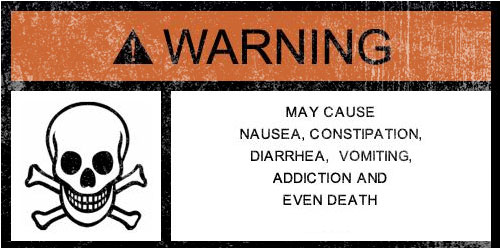We’ve all seen the advertisements—there’s a pill for every ill these days. Wonderful images of happy, well-adjusted folks; and then there’s the small print and the litany of side effects, up to and including death. But, hey, you’re not afraid to go outside anymore! And these are the “legal” drugs—they have to come with warning labels.
Illegal drugs are not accompanied by warning labels and often have a more devastating impact on our bodies. All drugs have side effects; all side effects are compounded exponentially when the abuse is excessive. Even tobacco products carry warning labels. Consider this your warning label for alcohol and chemical drug abuse.

Makes You Wonder…
Why would people do this to themselves? Perhaps because chemical abuse:
- Creates muscle loss due to poor protein intake, and can cause muscular inflammation and increased fat deposits and high blood pressure.
- Irritates the stomach increasing the risk of ulcers and gastric distress.
- Overworks the liver preventing bile production and filtering operations.
- Irritates the pancreas causing swelling which may block the flow of enzymes into the stomach resulting in digestive difficulties and diabetes.
- Inflames the kidneys causing frequent infections and increased water output resulting in excessive nutrient loss.
- Irritates, sedates, and aggravates the nervous system, none of which is good.
- Irritates and sedates membranes, including the esophagus, stomach, and rectum.
- Slows or increases transit time in the intestines, increasing the risk of poor absorption and certain types of cancer.
- Creates poor elimination via the rectum, potential diarrhea, and may cause hemorrhoids.
- Depletes the body of nutrients for healthy-looking hair and skin.
The human brain does not escape these calamities. All drugs of abuse act in the brain to produce their euphoric effects; conversely, they can act upon the brain to cause seizures, stroke, widespread brain damage that can impact all aspects of daily life, and changes in the brain that may lead to problems with memory, attention, decision-making, and even paranoia, depression, aggression, and hallucinations. Drug abuse can also inhibit cognitive functions, including learning and reasoning. Drugs can also foster overpowering maladaptive associations that may establish future cravings and drug-seeking behaviors, and create cognitive deficits that hamper sustained abstinence.
Finally, drug-related deaths have more than doubled since the early 1980s. There are more deaths, illness, and disabilities from substance abuse than from any other preventable health condition.
Alcohol, Opiates, and Stimulants
Having generally considered the impact of chemical abuse on the body, let’s mull over how these three party favorites specifically harm the body.
Alcohol abuse can impact the cardiovascular system, gastrointestinal system, and the central and peripheral nervous systems. Alcohol intoxication impairs two major organs involved in critical metabolism and nutrition: the liver and the pancreas. Other complications include diabetes,permanent liver damage (or cirrhosis), seizures, and shortened life expectancy. Additionally, alcoholism is one of the major causes of nutritional deficiency in the US, inhibiting the breakdown and consequent usefulness of essential nutrients; it impairs nutrient absorption by damaging the cells lining the stomach and intestines, and can even prevent the digested nutrients from being fully utilized by altering their transport, storage, and excretion. Alcohol abuse is often associated with medical illness, which can become a consequence of consistent and excessive drinking. Finally, long-term alcohol abuse can permanently damage memory.
Opiates (including codeine, heroin, and morphine) affect the gastrointestinal system. Opiates can also severely affect nutritional status. Opiate addicts often suffer from nausea, constipation, diarrhea, and vomiting. Electrolyte imbalances of sodium or potassium can occur.
Stimulant use (including crack, cocaine, and methamphetamine) leads to weight loss and malnutrition. Stimulants eliminate the appetite while stimulating metabolic rate, and interfere with sleep so addicts often stay awake for long periods of time, burning even more calories. They may be dehydrated and have electrolyte imbalances.
Scary Stuff
It’s your warning label, remember? Do you need something to calm your nerves? Not all of these side effects happen to every addict, but all of these realities are on the table when the addict takes a seat. We could delve into further details, but the picture is clear.
Nutrition, Nutrition, Nutrition
 However, all is not lost entirely once recovery crests the horizon. Some of the damage may even be reversible. In addition to ceasing all chemical abuse, and the other elements requisite of successful treatment, recovery needs to include proper diet, regular exercise, and vitamin and mineral supplements. This includes low-fat, high-protein meals that are rich in nutrients and focus on whole grains. Recovering addicts need to eat smaller and frequent meals, drink plenty of water, and limit the consumption of sugar and caffeine. The road to recovery is long and arduous, but the road to recovery’s door step has been treacherous and death-defying.
However, all is not lost entirely once recovery crests the horizon. Some of the damage may even be reversible. In addition to ceasing all chemical abuse, and the other elements requisite of successful treatment, recovery needs to include proper diet, regular exercise, and vitamin and mineral supplements. This includes low-fat, high-protein meals that are rich in nutrients and focus on whole grains. Recovering addicts need to eat smaller and frequent meals, drink plenty of water, and limit the consumption of sugar and caffeine. The road to recovery is long and arduous, but the road to recovery’s door step has been treacherous and death-defying.

